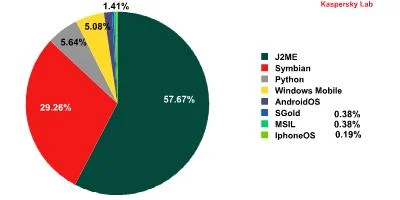The number of smartphone users is growing exponentially every day. Devices once considered the domain of the privileged classes are now affordable to the masses, with some selling for as little as $100.
Google’s Android OS has certainly made quite a successful entry into the mobile market, leaving the more established Windows Mobile trailing in its wake. Similarly, Apple’s iPhone and RIM’s Blackberry remain forces to be reckoned with, as they continue to expand their share of the market.

But the rapid proliferation of smart phones has not been all dandy – this glitch is due to the phenomenal rise in malicious phone software. And the numbers are not looking good.
According to Kaspersky, at least 514 variants and 107 families of mobile malware were registered in August 2009.
By the end of 2010 (14 months later), the number had jumped to 1,000 variants and 153 families – an increase of 94% and 44% respectively.

Overall, the mobile phone malware universe is dominated by SMS Trojans, which are applications coded to send an SMS to fee based shortened numbers.
Given that a good number of malicious codes are developed with a financial objective in mind, the SMS Trojan provides less complicated means of exploiting mobile phone vulnerabilities.
In addition, other models of malware are joining the fray and even the traditionally resilient iOS has not been spared.
What does the future hold?
Smartphone and ordinary mobile threats are expected to evolve in a number of ways. First, there is no sign pointing to a decline of SMS Trojans in the short term. SMS Trojans have and will continue to prove to be difficult to clamp down due to a weak legal framework in many countries as relates to cybercrime.
Second, Android’s growth will be a double-edged sword. Just as Microsoft has been forced to withstand a fierce onslaught from malware due to its unrivaled position as the PC OS leader, Android’s ascendancy is likely to cause it to become a prime target for viruses and cybercrime.
Third, the trends so far only point to an increase in total smartphone vulnerabilities over the coming years.






